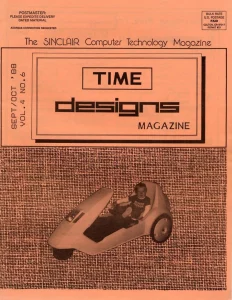| 2068 Graphic Goodies |
A couple of graphic goodies that won’t take hours to type in but demonstrate some neat graphic capabilities of the TS2068. |
Timex/Sinclair 2068 |
| Catch A Dragon! |
Program to plot “dragon curves.” A dragon curve is a regular fractal which forms from an infinitely repeated construction process. |
Sinclair ZX81, Timex/Sinclair 1000, Timex/Sinclair 1500 |
| Creating a Four Port Expansion Decoder |
Memory-mapped IO for the 1000 computer. |
Sinclair ZX81, Timex/Sinclair 1000 |
| Exclusive Interview: Nigel Searle, "Sinclair Insider" |
|
|
| First Class Fonts II |
1st Class Fonts II’s main program has three basic parts: a library of “fonts” (or type styles), a simple word process and a “definer” that allows the user to modify or change any character within one of the font sets. |
Timex/Sinclair 2068 |
| From the Editor |
About the cover: Tim Woods’ son in a Sinclair C5; Sinclair contracted with Hoover to manufacture the vehicle in the US. Paul Bingham designed the new logo. |
|
| It Came in the Mail |
Letters from readers. Solution to Puzzle of the Month from a prior issue; using serial printers with the TS2068; articles on disk; QL machine code; a program to keep young children occupied on the TS2068. |
Timex/Sinclair 2068 |
| Just Released |
Comprehensive public domain software library maintained by VISTA (Vashon Island Sinclair Timex) is available. Software available to perform color screen dumps to the Okimate 20, when connected via parallel interface. New business software from Bottle Cap Software, Byte Power. Zunk Custom Electronics is offering CADZ and games from Magicksoft. For QL users, EMSoft and Meta |
|
| Paul Bingham Evaluates the Z88: Is the New Computer Too Much of a Break From Tradition? |
|
Cambridge Z88 |
| Reader Survey Results Continued |
|
|
| Resident Procedures |
|
Sinclair QL |
| Spectrum Product News |
Twister boards and Spectrum ROMs available. Datel Robotarm, Romantic Robot Videoface, Rotronics Wafadrive, and Tascalc mentioned. |
Sinclair ZX Spectrum |
| Text87: An Advanced QL Wordprocessor |
|
Sinclair QL |
| The Newsroom |
A Sinclair IBM “Clone” (the Amstrad PC-1640 rebadged as a “Sinclair”). Summer T/S shows: Third Annual Northwest/International Timex Sinclair Mini-Fair; 1988 Midwest Timex Sinclair Conference. |
|
| The Programming Corner |
Questions about Larken disk system; programming in machine code; recovering from data loss. |
Timex/Sinclair 2068 |
| TS Communique: Your Hardware Problems Explored |
Mindware MW-100 printer with TS2068; composite/RGB monitor blanking when used with 1000; interfacing to TTL monitors; Hacksel interface with Radio Shack DMP-105; DMP-105 with Memotech I/F and 1000; non-linearity of 2040 printout. |
Timex/Sinclair 1000, Timex/Sinclair 2068 |
